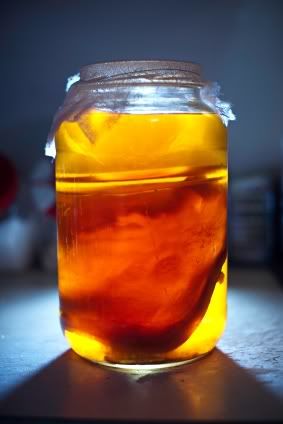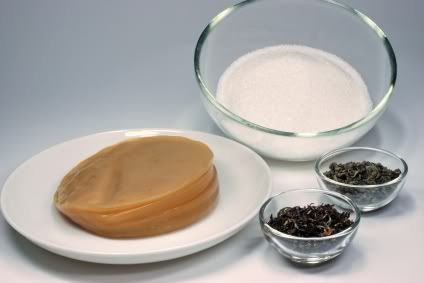Kombucha
Published: Wed, 01/18/12
January 18, 2011
Kombucha
-Mishelle Knuetson MH
 A vinegar-like drink that is re-emerging in popularity is Kombucha. The history of Kombucha is legendarily reported back to 220 BC by the Qin Dynasty for a Chinese emperor to use as an elixir. From there it spread throughout Asia. It is purported that in 414 AD a Korean named Dr. Kombu brought this famous tonic to an emperor in Japan and this is where the name was coined. Kombu for the doctor and cha is the Chinese name for tea. Kombu + cha = Kombucha. It has also been said that a "vinegary beverage" was carried into battle by Japanese warriors.
A vinegar-like drink that is re-emerging in popularity is Kombucha. The history of Kombucha is legendarily reported back to 220 BC by the Qin Dynasty for a Chinese emperor to use as an elixir. From there it spread throughout Asia. It is purported that in 414 AD a Korean named Dr. Kombu brought this famous tonic to an emperor in Japan and this is where the name was coined. Kombu for the doctor and cha is the Chinese name for tea. Kombu + cha = Kombucha. It has also been said that a "vinegary beverage" was carried into battle by Japanese warriors.
There appears to be a reawakening to cultured and fermented foods. In the past, many people used fermentation to preserve food. Now we are recognizing the great health benefits that come from cultured and fermented foods. These types of foods contain the probiotics that the body uses to aid in digesting proteins and fats more efficiently. They improve the nutritional quality of food, protect us from disease causing organisms (like Candida Albicans) and they boost the immune system. These foods also create an environment that is inhospitable for pathogenic microorganisms (disease causing). Dr. Christopher was well aware that digestion is the foundation of health - that is why he recommended using vinegar in your daily regimen.
 A vinegar-like drink that is re-emerging in popularity is Kombucha. The history of Kombucha is legendarily reported back to 220 BC by the Qin Dynasty for a Chinese emperor to use as an elixir. From there it spread throughout Asia. It is purported that in 414 AD a Korean named Dr. Kombu brought this famous tonic to an emperor in Japan and this is where the name was coined. Kombu for the doctor and cha is the Chinese name for tea. Kombu + cha = Kombucha. It has also been said that a "vinegary beverage" was carried into battle by Japanese warriors.
A vinegar-like drink that is re-emerging in popularity is Kombucha. The history of Kombucha is legendarily reported back to 220 BC by the Qin Dynasty for a Chinese emperor to use as an elixir. From there it spread throughout Asia. It is purported that in 414 AD a Korean named Dr. Kombu brought this famous tonic to an emperor in Japan and this is where the name was coined. Kombu for the doctor and cha is the Chinese name for tea. Kombu + cha = Kombucha. It has also been said that a "vinegary beverage" was carried into battle by Japanese warriors. In China traditionally the grandmother cared for the "culture" and then it was passed down from mother to daughter. From China this tradition was spread to Russia and ultimately all of Europe until World War II where rationing made it difficult to find sugar and tea.
Like vinegar, Kombucha uses the same type of "mother" in the fermenting process. The "mother" also known as "culture", "mushroom" or "baby", is the colony of bacteria and yeast that works in harmony to convert the nutrient solution into Kombucha. An easy acronym for this culture is SCOBY.
SCOBY=
Symbiotic
Culture
Of
Bacteria &
Yeast
What makes Kombucha different from vinegar is the nutrient solution in which it is brewed. Vinegar uses apple cider where Kombucha uses sweet tea, specifically tea from the plant Comellia sinensis. All black, white, green, and oolong teas derive from the same plant. It is how they are processed that makes them different. The most common teas used in Kombucha are black and green teas. The reason for this is that many "teas" do not contain what Kombucha needs to brew successfully over time. Some plants that are used in herbal infusions lack the necessary nutrients the culture feeds on in the transformation process. Without some Comellia sinensis in the brew, the Scoby may be harmed by the essential oils in the plant and it will retard the fermentation process and therefore stop the healthful benefits.
The magic of the fermentation process between the tea and the Scoby is that vitamins and enzymes are produced that weren't there before. Fermentation helps the poly-phenols, tannins, and antioxidants found in the tea to become more bio available (easier for the body to absorb and use).
There has been concern over the possible alcohol and caffeine content of Kombucha, as well as the sugar that is used to make the sweet tea (nutrient solution you add to the Scoby to make Kombucha). The sugar and compounds of the tea are digested by yeast and bacteria in the fermentation process. This is fuel for the Scoby.
In the book Kombucha by Christopher Hobbs, an instructor for the School of Natural Healing, he states "A cup of Kombucha tea (5 oz.) contains up to 5 mg. of caffeine. A strong cup of coffee contains about 100 mg of caffeine. So it is not a significant source of caffeine. Kombucha tea can contain ethyl alcohol ranging from 0.4 to 1.5%, but rarely over 1%. This is a very small amount. Many beverages, even apple juice, contain minute amounts of alcohol."
Kombucha, for many, is a healthier alternative to soft drinks and gives a person another choice when it comes to a fermented beverage other than vinegar. This drink is a good source of probiotics and enzymes for healthy digestion and it also produces various B vitamins, even B12, and healthy amino acids. Components of the basic brew are: Nutrient Solution (Sweet tea) + Starter Liquid (start from already brewed batch) + SCOBY + Time = Kombucha
For more information on the constituents found in Kombucha and detailed instructions on brewing, you can purchase the book Kombucha by Christopher Hobbs from Christopher Publications. There are only a limited number of books on hand (the book is out of print) so it cannot be purchased online. To order call 888-489-0155
Mishelle
Knuteson is certified in Rapid Eye Technology (RET) an emotional release
therapy, teaches classes in The Art of Feminine Presence and a Master
Herbalist ~ graduate of The School of Natural Healing. Mishelle currently works
as an Educative Master Herbalist (MH) for The School of Natural Healing and as
Office Manager of Christopher Publications.
Printable Version: click here
If you missed an article be sure to visit http://www.herballegacy.com and click on Articles. Also, take advantage of David Christopher's Radio Show (see Resource Links below for more information).
If you missed an article be sure to visit http://www.herballegacy.com and click on Articles. Also, take advantage of David Christopher's Radio Show (see Resource Links below for more information).
Christopher Publications & Newsletters
"Books for your Health & Well-Being"
The only place where Dr John R. Christopher's writings are published, with a hand picked selection of the best books to enhance your natural healing library.
Christopher Publications Newsletters: For many years Dr. Christopher published a monthly newsletter that covered everything from heart troubles to back pain; garlic to alfalfa and everything in between. These publications were not available for many years, but Christopher Publications has scanned all of them in and they are now available for you to download instantly. For more information or to purchase the newsletters visit: http://www.christopherpublications.com/Newsletters.html.
Kombucha
1 cup organic sugar (don't use honey or agave as it may disrupt the bacteria balance, white sugar is OK)
4-6 tea bags - for loose leaf tea, 1 bag of tea=1 teaspoon (at least 2 bags of tea should be from the Comellia sinensis plant)
Starter Culture-Scoby (can be obtained from a friend already making the brew or purchased from a web site such as www.kombuchakamp.com)
1 cup starter liquid - from a previous batch (or use vinegar)
1 gallon purified water

1 Gallon recipe
Ingredients:

Supplies:
10 Steps to Kombucha:
1. Heat 4 cups of water to just boiling
2. Add hot water and tea bags to brewing vessel and steep for 10 minutes
3. Remove tea bags
4. Add sugar, stir until dissolved
5. Fill the brewing vessel with cold purified water to about 2-3" from the top (This brings down the temperature of the mixture).
6. Test the temperature, it must be room temperature (lukewarm) before adding the Scoby
7. Add Scoby and starter liquid and fill the rest of the brewing vessel with water to the top
8. Cover with a cloth and hold in place with the rubber band. Don't use cheesecloth - the cloth must have a tight weave (you can use a coffee filter).
9. Put away in a warm dark place. Ideal brewing temp is between 70-77 degrees F. Don't disturb it for 7-10 days. The longer you go the stronger and more vinegary/tart tasting it will be.
10. Remove Scoby and at least a cup of the brew to a glass container for next batch (Do not touch the Scoby to metal). Pour your Kombucha into bottles and store in refrigerator or another cool place until consumption.
Printable Version: click here
Herbal Resource Links
- Herbal Legacy - http://www.herballegacy.com - Our free information website
- The School of Natural Healing - http://www.snh.cc - Quality Education since 1953
- Christopher Publications - http://www.christopherpublications.com - Dr. Christopher's books and more
- Christopher Websites - http://www.christopherwebsites.com - Find all Christopher websites and other great resources
- A Healthier You Radio Show - http://www.ahealthieryouradio.com - Free weekly radio show
This newsletter is sponsored by:
The School of Natural Healing: http://www.snh.cc
Christopher Publications: http://www.christopherpublications.com
The School of Natural Healing: http://www.snh.cc
Christopher Publications: http://www.christopherpublications.com
NOTICE: All
information in this newsletter is given out as information only and is not
intended to diagnose or prescribe. For
our official Disclaimer, Biological Individuality, Important Notice & Terms
of Use please see: http://www.herballegacy.com/Disclaimer.html
This newsletter is sent by permission only - you can unsubscribe quickly and easily by clicking the link below.
.

